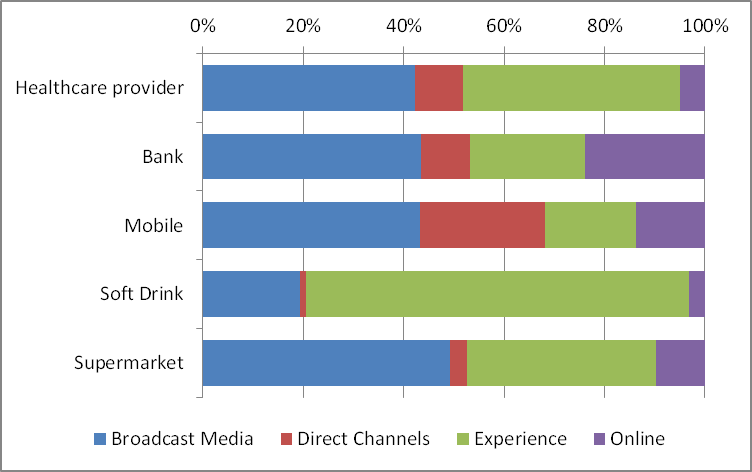Healthcare was one of five sectors looked in the Pleased to Meet You research (the other four were Banking, Supermarkets, Soft Drinks, and Mobile). In the UK the majority of healthcare is publicly funded, and so healthcare was chosen to as a representative of the public sector. It allows us to contrast commercial vs. private approaches to customer engagement, and see what lessons we can learn.
How do different sectors communicate?

We'll begin with a look at the overall communication mix that the different sectors use. From the graph on the left, you can see that on the face of it, the healthcare sector does not significantly differ from other sectors. The broadcast media features strongly in the communication mix, direct channels fall into the mid use, and online whilst a little weak isn’t as low as for soft drinks.

Digging a bit deeper into the data we discover one critical difference between the public and commercial sectors in the origin of communications delivered through broadcast media such as television, press and radio. This can be clearly seen in the graph on the right.
As can be seen, whilst the majority of communications about the commercial sectors in broadcast media are in the form of advertising and sponsorship. In contrast news stories are the primary form of communication for healthcare providers in these channels. This helps explains why radio represents a five times larger share of healthcare’s media mix.
If we separate commercial providers of healthcare from the UK’s primary public sector provider (the NHS), then we find that they are able to counteract the healthcare news agenda to a degree through their own promotions, although unusually this tends to take the form of sponsorship rather than explicit advertising.

What does this mean for the perception of healthcare organisations?

The bubble chart to the right shows how survey participants felt about the various sectors when they encountered them on the television. For the commercial channels, where those encounters are primarily promotional, these encounters are perceived in a relatively neutral fashion. Unfortunately for healthcare providers, with news dominating the agenda, the public perception of the sector generated by television is significantly more negative.

We can contrast this with the actual experience when the customer uses the service. Here we see that direct experience of healthcare services gained through visits to the doctors surgery or hospital are the most positively received of all the “on-premise” experiences, though it is only a slight advantage.
Lessons for Commercial Organisations
 Probably the key and to fairly well understood learning from this research is that no matter how good your level of service, poor service and failures to deliver are what make the news, and are communicated both publicly, and also through word of mouth. Whilst advertising and promotion do provide an opportunity to transmit a positive image of an organization, if that media is dominated by the bad news stories you will be fighting an up-hill battle.
Probably the key and to fairly well understood learning from this research is that no matter how good your level of service, poor service and failures to deliver are what make the news, and are communicated both publicly, and also through word of mouth. Whilst advertising and promotion do provide an opportunity to transmit a positive image of an organization, if that media is dominated by the bad news stories you will be fighting an up-hill battle.
Social media, whilst still a relatively small part of most people’s lives does have the potential, as has been shown in a number of high profile cases, to magnify word of mouth. This means an incident which would not normally have been picked up by the traditional media risks becoming an overnight sensation and having a significant impact on brand value.
What does this mean for organisations? It means you need to adopt an unrelenting focus on quality of service and delivery. It means living up to the promises made in advertisements or discount vouchers. It means identifying when things go wrong and then acting swiftly to put them right. And finally, it means understanding that the trust and loyalty of your customers may be hard earned, but easily lost.

